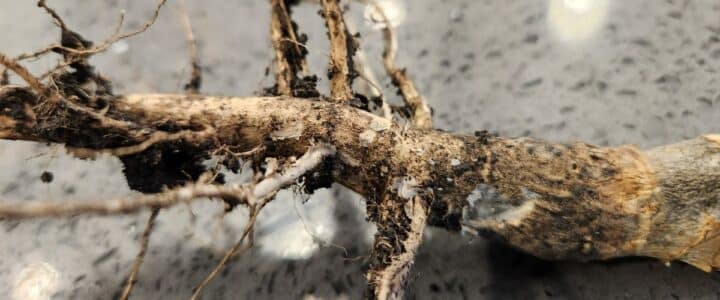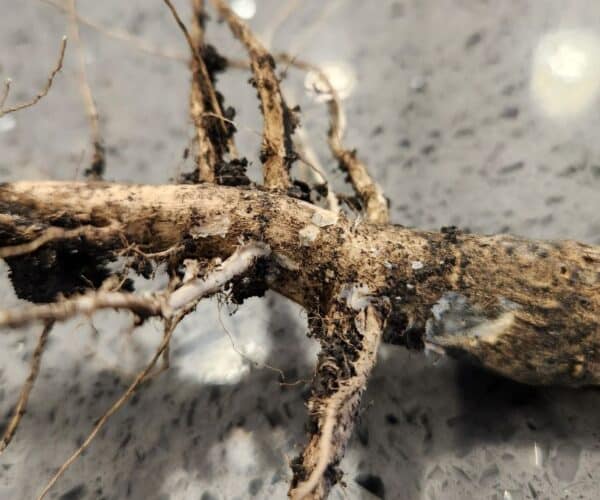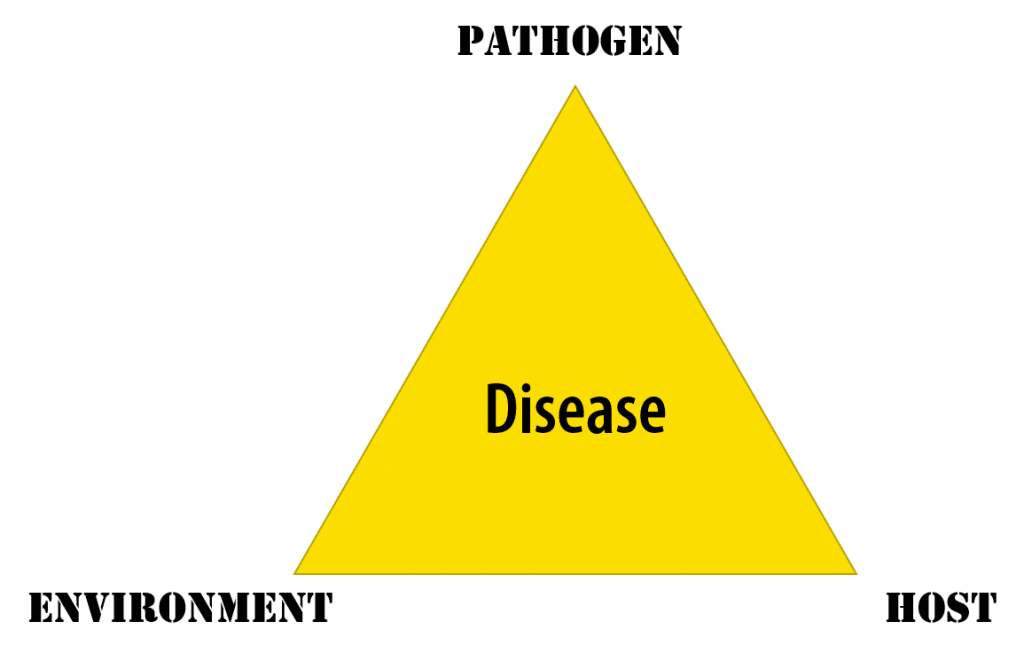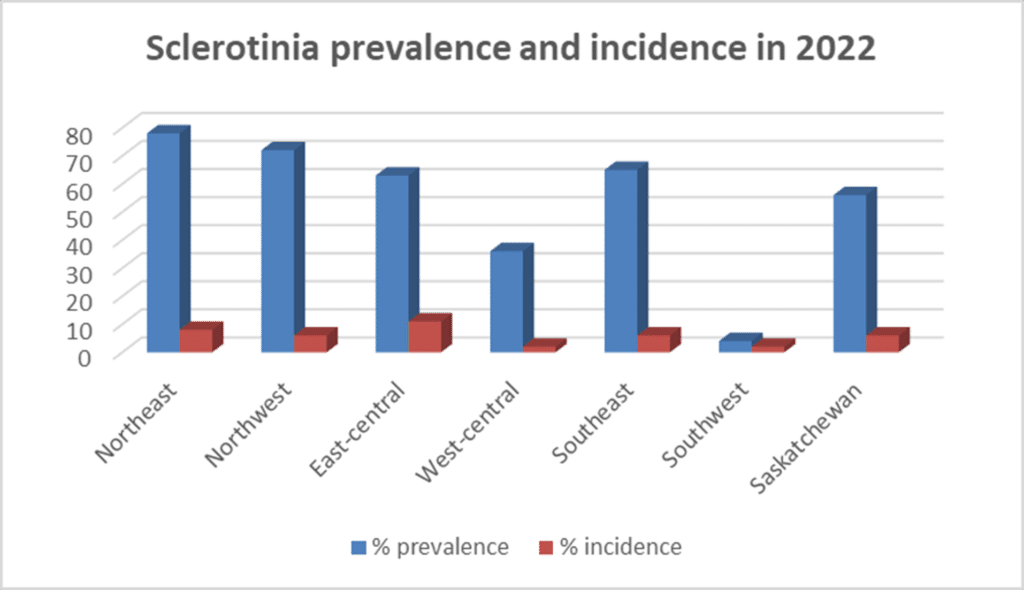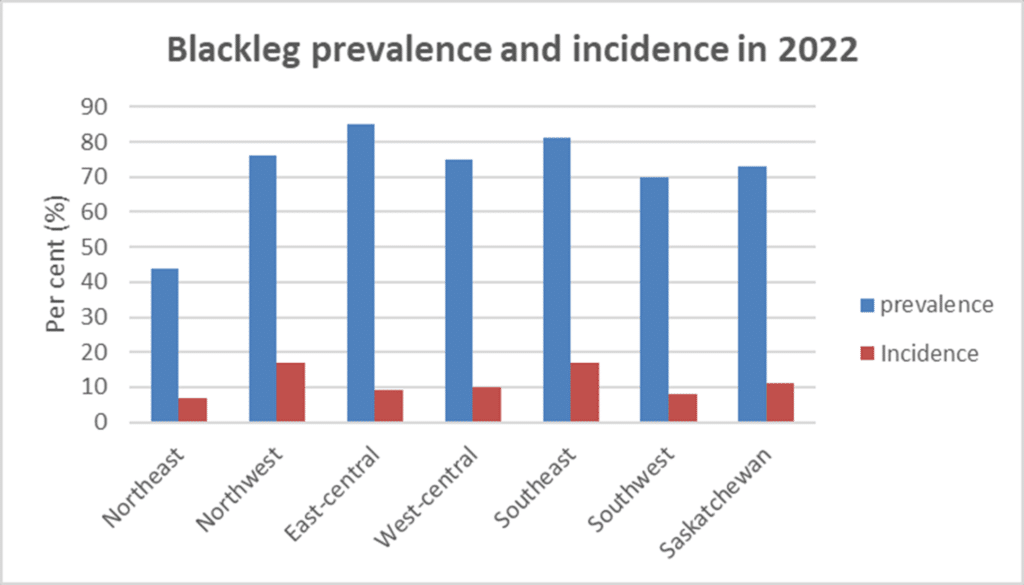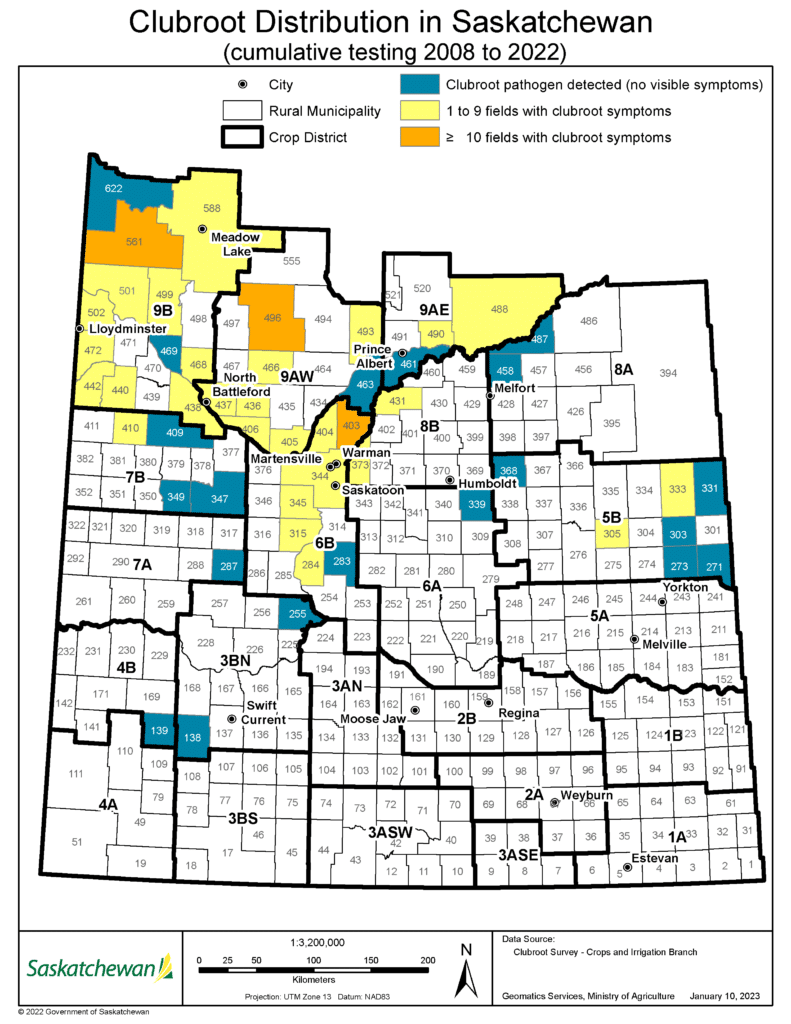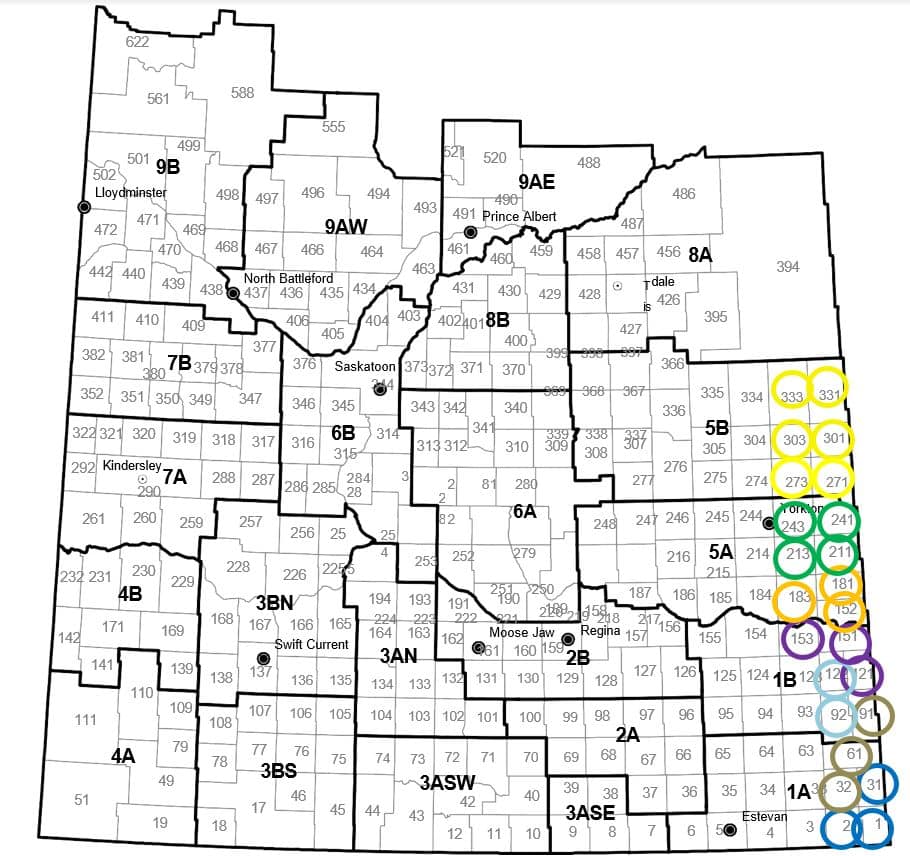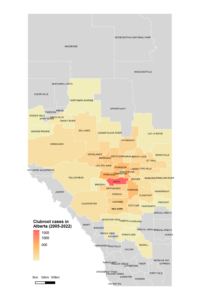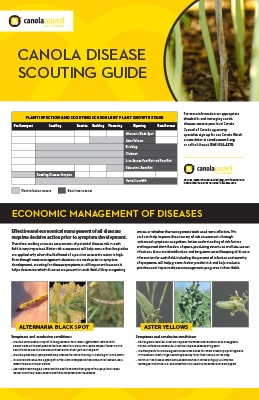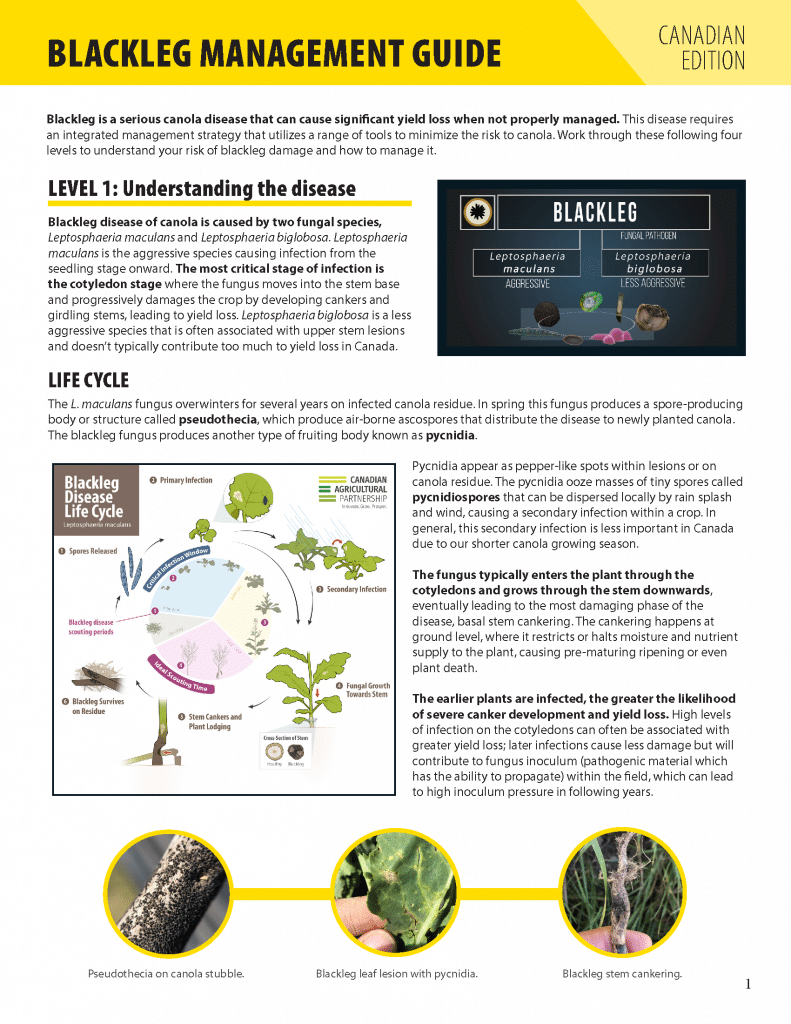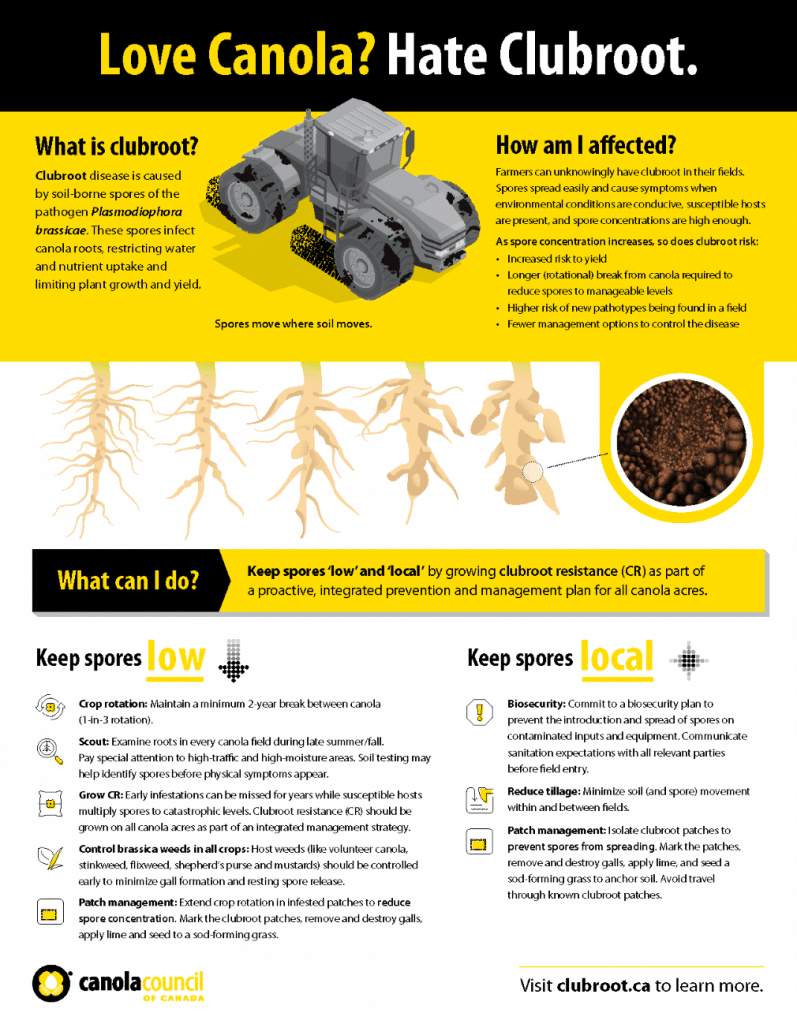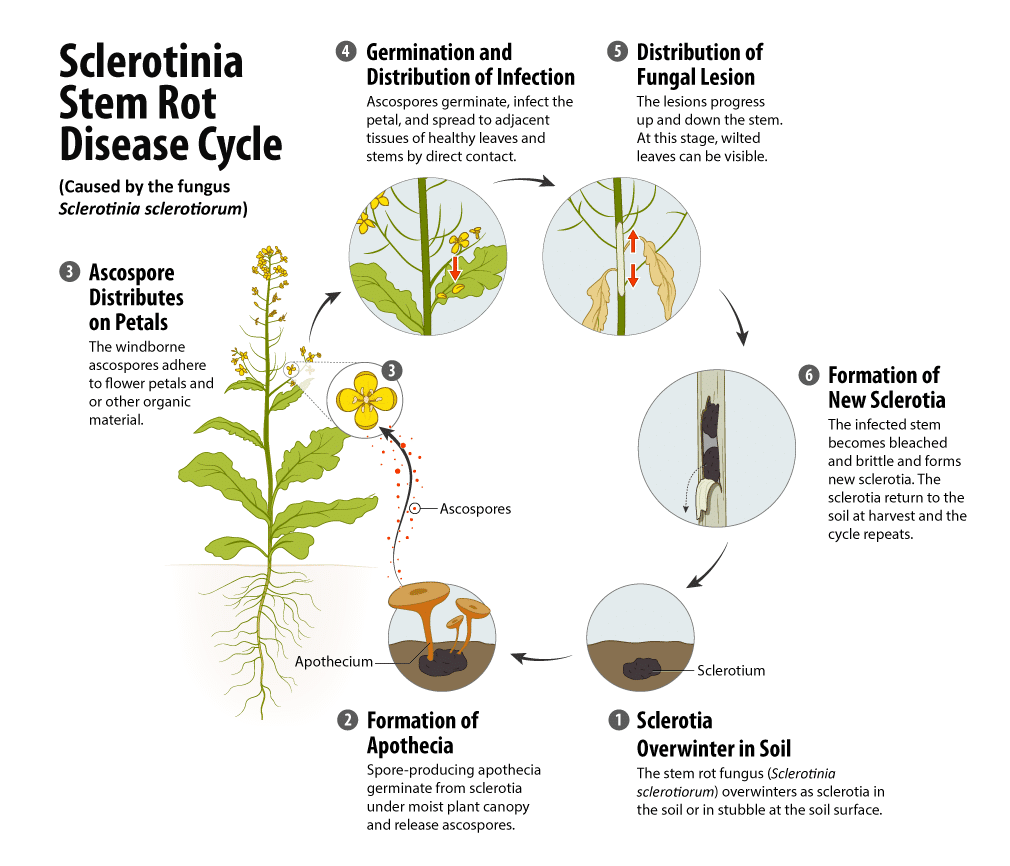Hindsight is 20/20, and this can be a positive thing. For instance, reviewing canola disease results from the 2022 surveys and recalling management decisions made in 2022 can provide insight on potential risks and optional improvements for the upcoming growing season. This blog summarizes the Manitoba, Saskatchewan and Alberta 2022 canola disease survey results for blackleg, clubroot, sclerotinia, verticillium stripe as well as some resources options to support your disease management practices in the 2023 crop year.
Annual canola disease surveys
Though the Coordination of a crop disease monitoring network for Western Canada project is still in progress, it has already established a Prairie Crop Disease Monitoring Network (PCDMN) that integrates existing disease monitoring and surveillance and reporting activities into an overall monitoring initiative for Alberta, Saskatchewan and Manitoba.
The notes from the Western Committee on Plant Diseases Annual Meeting from the Western Committee on Plant Diseases of the Western Forum on Pest Management provide a brief account of the crop diseases in Western Canada in 2022. A comprehensive annual of the plant disease situation in 2022, will be posted in the Canadian Journal of Plant Pathology once finalized.
As noted in a previous blog, disease impact is reported by prevalence, incidence and severity, where:
- Prevalence is the percentage of fields surveyed that have the disease.
- Incidence is the percentage of plants surveyed within each field that have symptoms of the disease.
- Severity is the proportion of plant tissue that shows disease symptoms.
Apply this research on your farm
- Check the Canadian Current Drought Conditions map to inform potential disease management options for 2023.
- In addition to blackleg, clubroot and sclerotinia, remember to check for verticillium stripe when scouting canola fields this year, using the Canola Disease Scouting Guide.
- Contribute to Saskatchewan surveys by becoming a Volunteer Crop Reporter in 2023!
- Subscribe to Canola Watch and follow the Prairie Crop Disease Monitoring Network (PCDMN) for updates this growing season.
- Use the CCC’s phenology tracking sheet to document in-season disease management decisions (for post-season review and assessment).
Environmental conditions contributing to 2022 disease outcomes
In addition to the host plant (canola) being present and pending the presence of the disease-causing pathogen, the biotic and abiotic environmental conditions (that includes weather events) should also be considered in resulting plant disease outcomes (as depicted by the disease triangle).
The environmental conditions in 2022 varied greatly by location, especially regarding precipitation events. Excessive precipitation was reported in the eastern Prairies and the Peace River region throughout April and May and below average temperatures between early April to early June were recorded for most of the Prairies. These factors contributed to late seeding in some areas, increased variability between regions, and emphasized the variability in fields (especially those with greater topographical variability). Late June heat helped some delayed crops catch up, caused stress for some crops, and further increase variability in other instances. Fortunately above average temperatures in September and October allowed for the canola crop to be harvested before winter conditions set in. While the weather data inferred that disease pressure ranges from no impact to moderate impact, the canola disease survey data provides a more precise account of the canola disease situation in Prairies in 2022.



Looking ahead, the Canadian Drought Monitoring maps can be utilized to estimate the drought conditions, based on temperature and precipitation measures throughout each month, which could factor into potential management options this coming crop year.
Provincial disease updates
Manitoba 2022 disease report
Manitoba’s annual canola disease survey has taken place since 1971 and is coordinated by Manitoba Agriculture in collaboration with Agriculture and Agri-Food Canada (AAFC), and supplemental submissions from canola industry members. The 2022 Manitoba Canola Disease Survey included data from 115 fields across the canola growing regions of the province. Surveying occurs as canola is ripening (30-40% seed colour change) to assess for the prevalence (% crop infested) and incidence (%plant infected) of alternaria, aster yellows, blackleg, clubroot, foot rot, sclerotinia and verticillium stripe.
In each field, 100 plants are selected from a “W” pattern, where the five points of the “W” are at least 20 paces apart. All plants are pulled from the soil and individually examined for presence of disease. Soil samples can also be collected to test for the presence of clubroot spores in the soil. Additional details are available in the surveillance of canola diseases in Manitoba page.
In Manitoba Agriculture’s 2022 Provincial Seasonal Summary Crop Report, it was noted that strong winds initiated a widespread lodging event in mid-bloom canola in July, leading to a flat canola crop at harvest across some Manitoban geographies. Lodged canola may have increased the prevalence of sclerotinia and other diseases in 2022, and led to lower realized yields due to challenging growth and harvest methods. The canola disease survey results provided in the table, graph and map showed that verticillium stripe prevalence continued to increase in 2022, clubroot remains a concern and blackleg and sclerotinia and both had notable prevalence and incidence.
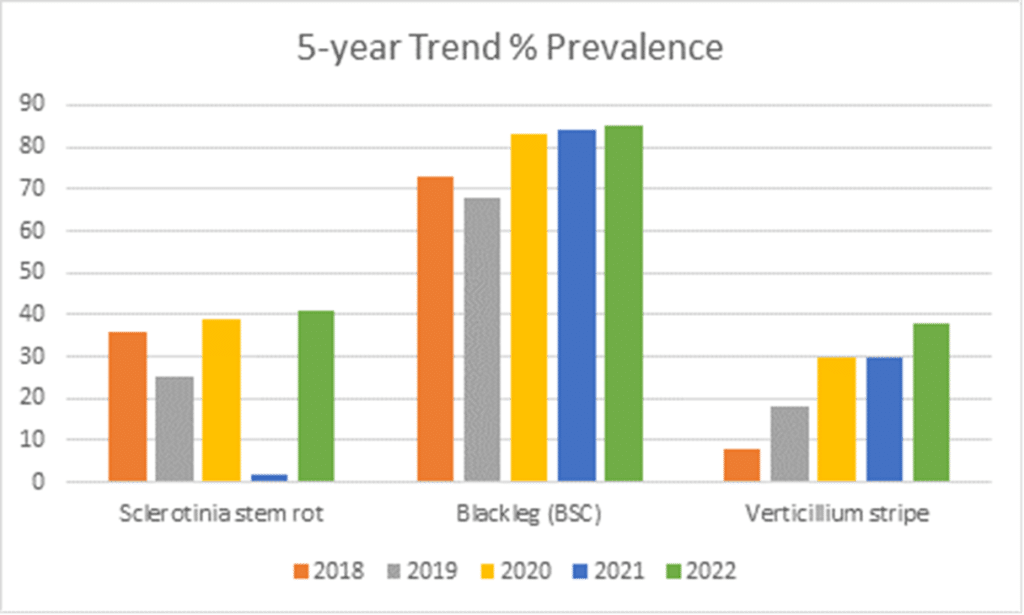
| Canola disease | Prevalence | Incidence | Severity |
| Blackleg | 85% | 13% | 1.2* |
| Sclerotinia stem rot | 41% | 3% | 1.2* |
| Pod spot (alternaria) | 17% | – | 1.9** |
| Aster yellows | 4% | 3%** | |
| Verticillium stripe | 38% | 23%** | |
| Clubroot | 0 | – |
*Incidence and severity of BL and/or SSR based on ALL crops surveyed.
**Severity of Alternaria pod spot, and Incidence of Aster Yellows and Verticillium stripe based ONLY on infested crops.
Data source: Manitoba Agriculture.
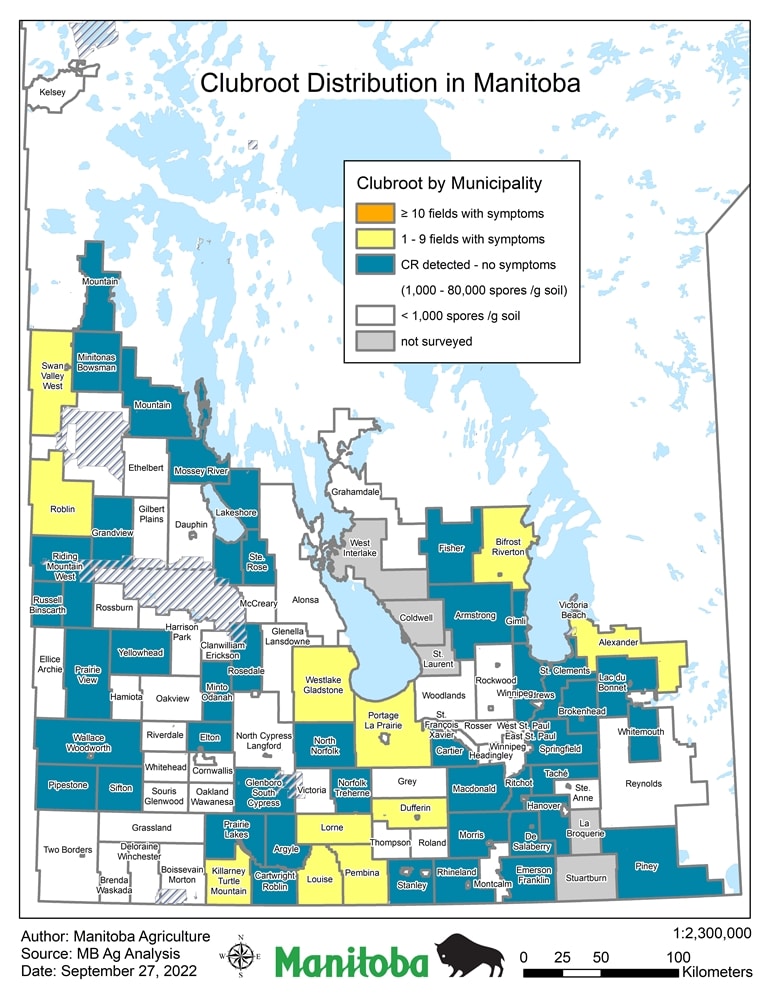
Saskatchewan 2022 disease report
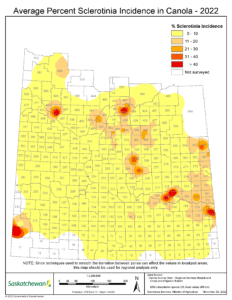
Saskatchewan’s annual canola disease survey is carried out by the Ministry of Saskatchewan and its survey partners.
A total of 205 canola (Brassica napus) fields in the major canola production regions of Saskatchewan in 2022 were surveyed in the general disease survey. All fields were surveyed with the producers’ permission. Disease assessments were made in each field by collecting 20 plants from five different sites, each at least 30 meters from the edge of the field. Plants were assessed in each field and incidence and prevalence was recorded for diseases and severity was rated for some diseases.
This survey covered the northwest (29 fields), northeast (32 fields), west-central (28 fields), east-central (52 fields), southwest (27 fields) and southeast (37 fields) areas of the province. Blackleg basal symptoms were present in 73% of canola crops surveyed in Saskatchewan in 2022. The average incidence in the province was 11%. The average severity of basal cankers across the province was 0.16.
Sclerotinia stem rot (Sclerotinia sclerotiorum) was observed in 56 per cent of the crops surveyed. Average incidence across all crops surveyed in the province was six per cent. The average severity of sclerotinia stem rot across the province was 0.18. The overall mean incidence for the province was higher than in 2021 (two per cent) but lower than 2020 (17 per cent). Higher disease incidence in 2022 compared to 2021 can be attributed to the weather during the growing season.
Canola crops in the Saskatchewan survey reported the presence of aster yellows in 3.9% of fields, alternaria black spot in 51% of fields. Verticillium stripe was not confirmed during the general canola disease survey in any of the 205 surveyed fields assessed in 2022. However, of the 25 fields surveyed in a separate, targeted, after-harvest verticillium stripe-specific survey in 2022 (see map of specific area surveyed where it was expected to find verticillium stripe) 64% of fields surveyed had suspect samples with average incidence of 9.7%.
In a specific effort to monitor the spread and distribution of clubroot across the province and encourage proactive on farm management of this disease, a clubroot-specific survey was conducted. Within this survey, >520 fields were examined, and results were used to generate the provincial clubroot distribution map. Highlight outcomes include: visible symptoms being found in two more commercial canola fields (bringing the cumulative total to 82) and clubroot DNA being detected in four more commercial canola fields, bringing the total to 42.
To contribute to the surveying efforts, become a Volunteer Crop Reporter for 2023 and fill out the Pest Monitoring Sign-up Form.
Alberta 2022 disease report
Alberta’s annual canola disease survey is carried out by Alberta Agriculture in collaboration with AAFC, the University of Alberta, Olds College and additional contributors. The Alberta canola disease survey is done in collaboration with the Alberta Association of Agricultural Fieldmen. It aims to evaluate 1% of canola fields in each county/MD in Alberta that has canola growing. The survey achieved 322 fields in 2022.
Key summary notes from Michael Harding’s Field crop disease update for 2022 during Agronomy Update 2022 included that some diseases very responsive to weather, clubroot on canola continues to spread and blackleg levels in canola higher in 2022. More specifically the disease survey revealed:
- Clubroot prevalence was 10.8% and estimated disease incidence was 20%.
- Blackleg prevalence was 99.1%, incidence was 26.5% and average severity was 0.54.
- SclerotinIa stem rot prevalence was 44.5% and incidence was 3%.
- Symptoms of verticillium stripe were observed in seven fields (2% prevalence), however, laboratory testing failed to confirm the presence of V. longisporium. For the past three years surveys have revealed 2-5 fields with symptoms suspicious for V. longisporum, but none have tested positive thus far.
Learn more details in the Final Alberta Crop Report for 2022 document.
Tools and resources to prepare for 2023
There are a several resources to help with disease identification and disease management actions to implement in the growing season to minimize disease impact and record-keep for future lessons.
Actions to implement in 2023 to improve disease management:
- Make a record-keeping plan: use the CCC’s phenology tracking sheet to help document in-season decisions and review post-season.
- Assess the stand: use the CCC’s Canola Calculator to record plant counts for refining seeding specifics and to contribute to the seasonal Canola Counts maps generated with these data points.
- See how the pathogens impact canola and how it to manage them in the Canola Disease videos.
- Scout (or have your agronomist scout) your fields using these helpful disease scouting guides.
- Get tested! Take advantage of the plant disease testing programs offered by SaskCanola and the Manitoba Canola Growers or utilize 20/20 Seed Labs or other the labs in Alberta to find out what is your field.
- Stay up-to-date with these helpful options:
- Sign up yourself/your agronomist for Canola Watch.
- Follow the Prairie Crop Disease Monitoring Network (PCDMN) for updates.
- Subscribe to the Prairie Pest Monitoring Network for wind trajectory maps informing aster yellows risk.
- Remember to always Keep It Clean: ensure you are following blackleg management recommendations and make use of the Spray to Swath calculator for all fungicides.
Published February 23, 2023


